In L.A.’s Echo Park, a New Urban Development Takes Flight
http://decor-ideas.org 06/20/2015 03:13 Decor Ideas
On a perch high in the hills of Los Angeles sits Blackbirds, a new “microneighborhood” of 18 charcoal-gray and white modernist cottages in a woodsy setting. But this is no remote mountain, canyon or suburban dwelling — these homes are in urban Echo Park, one of the city’s oldest and most densely populated neighborhoods, near downtown L.A. and practically in the shadow of Dodger Stadium.
The Blackbirds project, which debuted last weekend, is part of a trend — especially among young urbanites — toward smaller dwellings in walkable neighborhoods close to commercial districts and transit systems. It’s also something of a backlash against suburban sprawl and McMansions with lot-line-to-lot-line footprints, a staple in many L.A. neighborhoods.
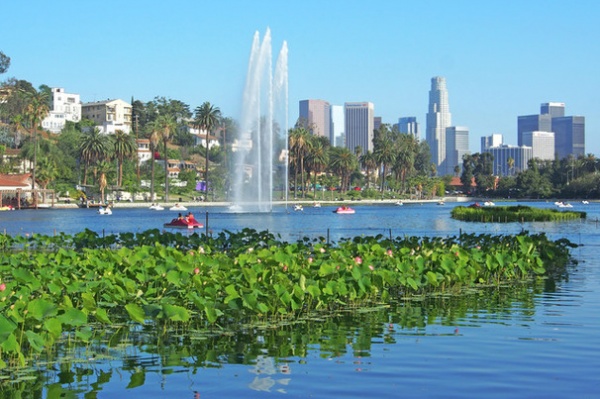
Photos by Julie Sheer
A short drive from Blackbirds is Echo Park Lake, a popular local attraction. The historic landmark was built as a reservoir in 1870 and is known for its paddle boats and lotus flowers. A lower section of the hilly Echo Park neighborhood is seen to the left of the lake. Downtown L.A., a few miles to the south, can be seen in the distance.
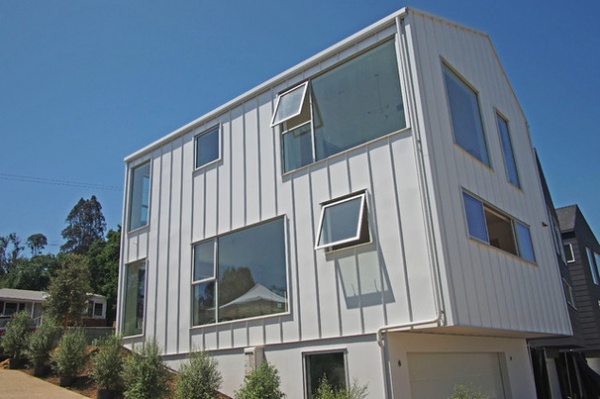
With their pitched roofs and shiplap siding, Blackbird’s homes were created to blend in with the diverse neighborhood’s 1920s cottages and Craftsman homes. Developer LocalConstruct and architect Barbara Bestor built the black and white structures in groupings of multistory, single-family, freestanding homes in two- and three-bedroom configurations. The floor plan names are in keeping with the avian, rustic theme: Perch, Nest, Trail and Brewer. The homes are clad in HardiePanel vertical siding, a fiber cement composite by JamesHardie.
The mini neighborhood features drought-tolerant and climate-appropriate plantings designed by noted landscape architect firm Mia Lehrer + Associates. “Our planting selection responds to the microclimate of the Echo Park Avenue ‘valley’ and its surrounding landscape but were also selected for their ability to perform — from providing privacy screens and forage opportunities to bringing delicious garden scents and supporting bees and butterflies,” Mia Lehrer says.
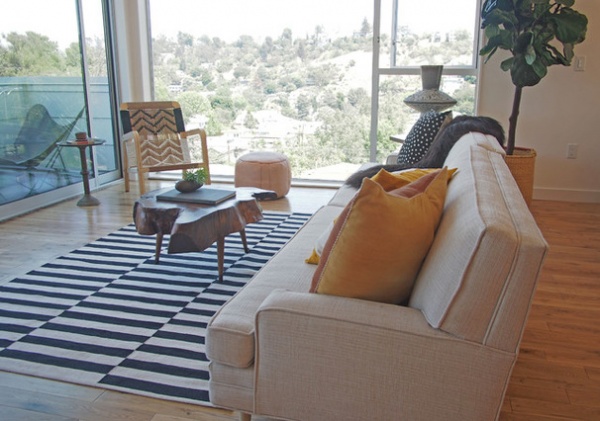
Large, high-efficiency windows allow for expansive views of the surrounding neighborhood and Echo Park canyon. Shown here are views from the living room of one of the Brewer houses.
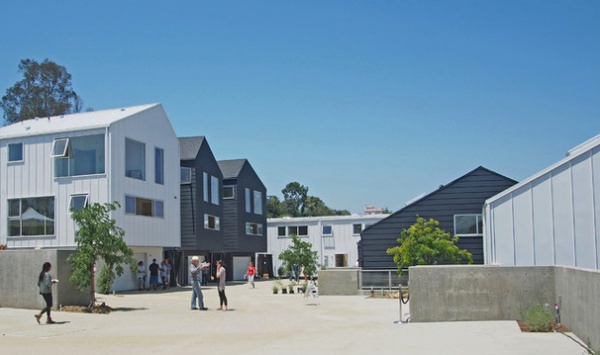
The main common area, and a central focus of Blackbirds, is a pedestrian- and bike-friendly public space dubbed a “woonerf,” a term and idea borrowed from the Dutch that emphasizes neighbor interaction over auto traffic. Six of the homes have two-car garages, and each of the remaining 12 has two uncovered spaces. The public area will accommodate extra parking, bikes and people.
LocalConstruct cofounder Casey Lynch says the woonerf (pronounced “vone-erf”) is “an area where you can have a barbecue, throw a ball or simply chat with your neighbor in passing. It fulfills our concept of a living street in that it isn’t entirely focused around the automobile.” It appeared to fit that description at the project’s public opening, seen in the photo above.
The hillside location allows for expansive views of nearby Echo Park canyon and downtown L.A., 3 miles away. Eco-consciousness was a big part of the design plan for this project, located in a formerly gritty neighborhood that is rapidly gentrifying — stroller-pushing parents share the sidewalks with tattooed skateboarders.
Built as a residential urban infill project under the city’s Small Lot Ordinance — with its mandatory compact building footprints and reduced street setbacks — Blackbirds is helping fulfill L.A. mayor Eric Garcetti’s mandate of adding 100,000 housing units to the city by 2021. Since the ordinance went into effect in 2005, more than 2,000 small-lot homes have been built in the city, especially in trendy areas such as Echo Park and nearby Silver Lake and Eagle Rock.
The ordinance’s design guidelines dictate that new small-lot homes have no shared foundations or common walls. And, as opposed to condominiums, tenants own the land the homes sit on and are responsible for their own maintenance. Local Construct’s Lynch says that at Blackbirds a monthly fee of about $100 will cover landscaping maintenance of common areas.
Lynch says they aimed for “stealth density,” meaning there appear to be fewer homes than actually exist. “By making the community have a lighter, more open feel, we think it will be more palatable than a big, bulky building,” Lynch says. That airiness continues inside the homes, which have high ceilings and open floor plans.
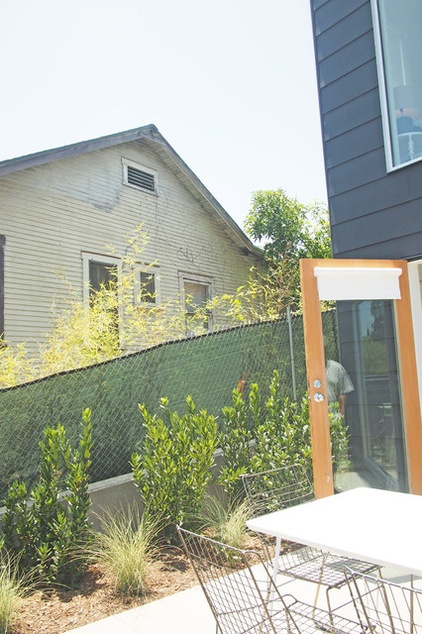
Such thoughtful construction would seem to be a welcome addition to any neighborhood. But residential infill isn’t without issues. In the case of Blackbirds, parking and traffic were big concerns for neighbors closest to the project. Lynch says he believes those fears were allayed and that most residents now support the project.
But evidence of discontent still exists. Some residents have posted signs objecting to the development. One directly across from the entrance on Vestal Avenue calls for a “moratorium on small lots” and laments the increase in “density, traffic, loss of privacy and views.” Shown at left is an existing home as seen from the deck of one of the Trail model homes.
With new infill construction, which skews toward modern design, there’s often concern about compatibility with existing properties. And since many of the new structures tend to be vertical and multistory, they sometimes tower over neighboring homes.
But Lynch says Blackbirds blends in well with the diverse neighborhood, and the design mimics existing homes: “We feel that the innovation and design in Blackbirds is very representative of the creative and cultural heritage of the neighborhood. Physically, the site plan and massing of the homes are very similar to their surroundings.”
Another complaint among critics of new infill is that L.A.’s small-lot ordinance isn’t living up to the promise of making homes more affordable: For example, the 1,300- to 1,900-square-foot Blackbird residences are priced from the high $700,000s to about $1 million. Even in pricey L.A., that’s on the high side of affordable, especially in Echo Park, where the average home price was about $600,000 in April 2015, according to Zillow.
But infill construction seems to be fulfilling a housing need. As many cities, Los Angeles included, revitalize their downtowns, demand for new housing is high. Cities that lost residents to the suburbs in the 1970s and 1980s because of crime and poorly performing schools got them back in the 1990s, and the trend is continuing, according to the nonprofit Urban Land Institute.
The attraction of cultural opportunities and newly vibrant downtown areas has led many to flock to cities, resulting in a boom in the construction of infill projects at former industrial sites and underused commercial properties, especially in Los Angeles, San Francisco, Portland, Seattle, Denver and New York.
Such building makes neighborhoods livelier, increases the tax base and preserves rural land threatened by suburbanization, according to the Environmental Protection Agency. An EPA report in 2012 said that infill housing development is accounting for an increasingly larger share of new home construction. In San Jose, California, eight out of 10 new homes built between 2005 and 2009 were infill.
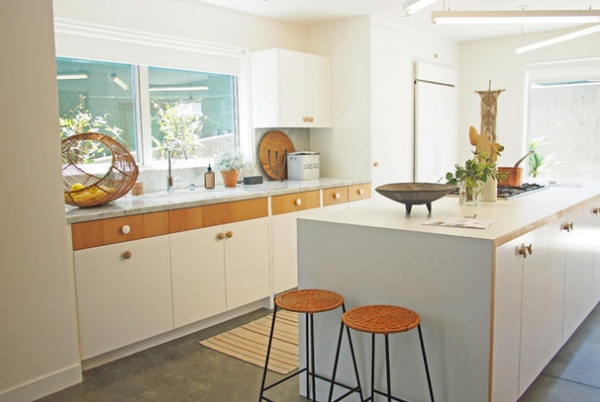
Inside the houses, the developers have paid attention to details. The kitchen countertops are marble, and the island countertops are custom fabricated. A Bosch range and cooktop are built into the island. Drawers are faced with vertical-grain Douglas fir, and the custom cabinetry was crafted and painted by local artisans.
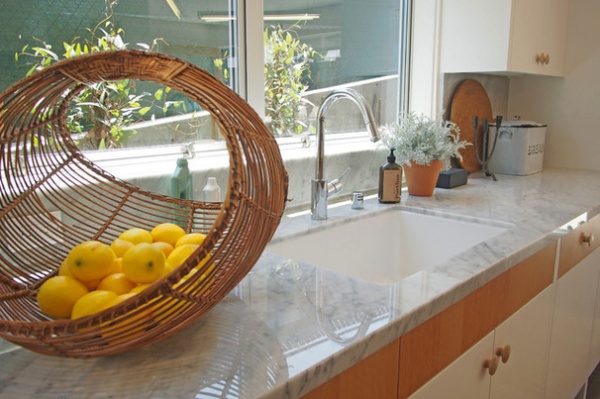
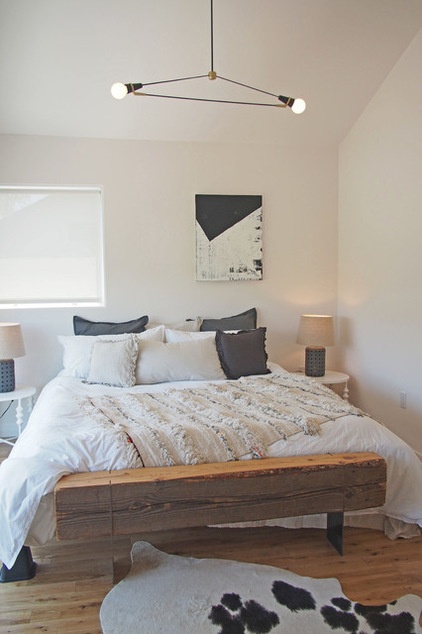
The lighting in all the Blackbirds homes is from Brendan Ravenhill, a lighting studio located in the Frogtown neighborhood of Los Angeles. Shown at left is a bedroom ceiling fixture in one of the Trail model homes.
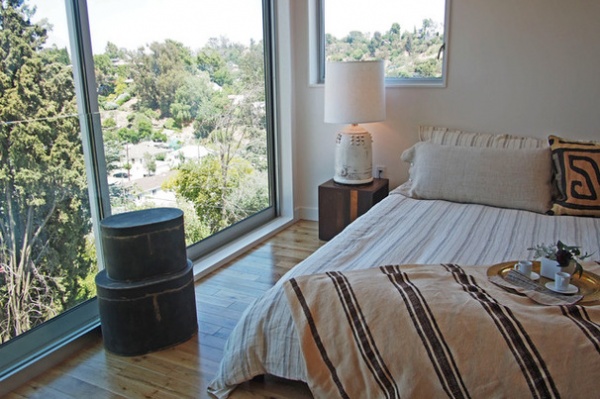
The master bedroom in a Brewer home enjoys a view of the hillside neighborhood.
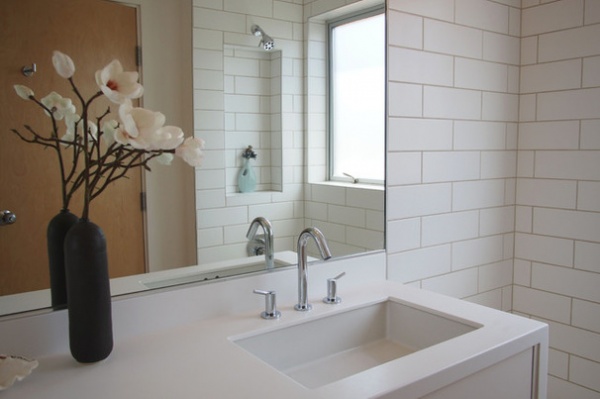
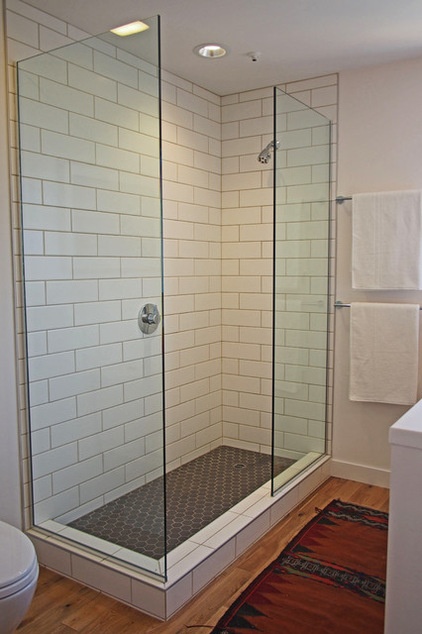
The bathrooms include understated white subway tile and unique sink and faucet configurations.
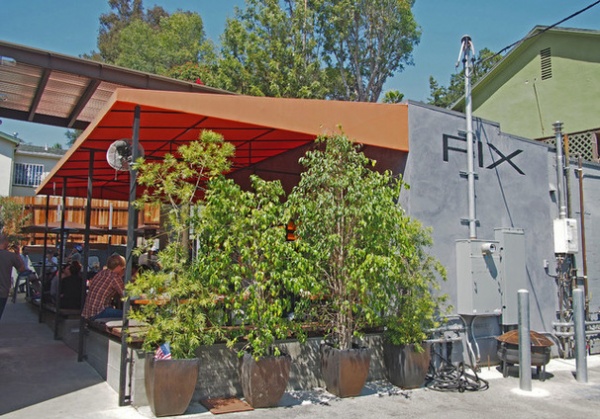
Vibrant Echo Park is a short (but steep) walk, bike or bus trip from Blackbirds. On nearby Echo Park Avenue is the popular Fix Coffee, with its outdoor patio.
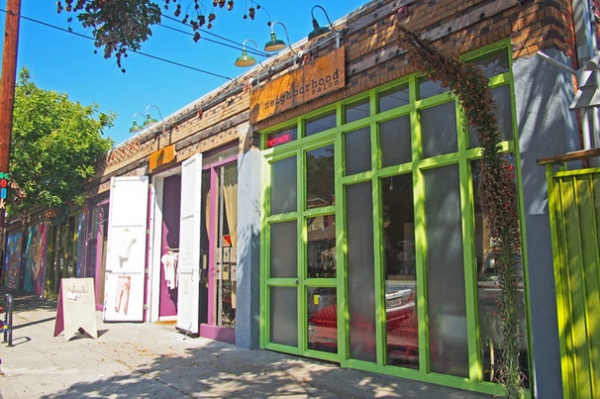
The avenue is home to trendy shops and includes stops for Metropolitan Transit Authority DASH buses, which connect Echo Park to downtown L.A. and neighboring communities.
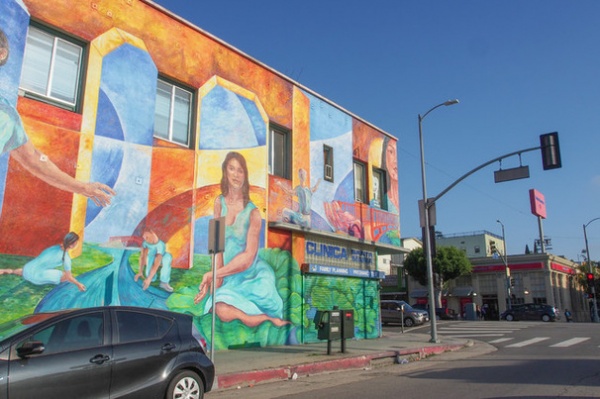
Echo Park is known for its murals, more evidence of its cultural history, which LocalConstruct’s Lynch thinks is a perfect fit for projects like Blackbirds. “Echo Park has an amazing cultural and architectural heritage,” he says. “The neighborhood is known for innovative modernist architecture but has renowned eclecticism and wonderful examples of Craftsman and Victorian architecture. This gave us a great framework to work within. Our approach to development is always contextual — we want to build projects that work within the existing fabric of a neighborhood.”
Lynch says he hopes Blackbirds sets a precedent for the type of housing L.A. needs. “You can only change so much about L.A.’s nature — we can’t build high-rises in neighborhoods like Echo Park but still need to address density,” he says.
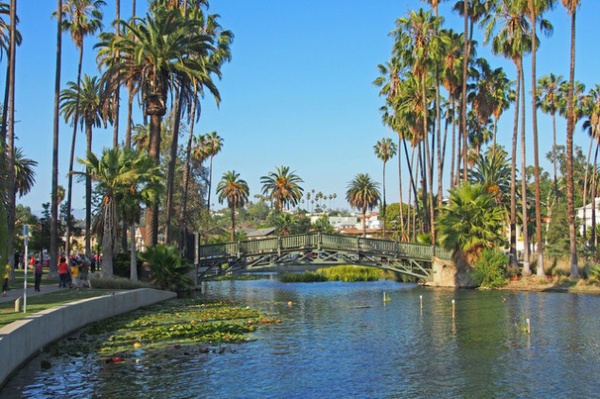
After years of neglect and overuse, Echo Park Lake was closed for rehabilitation for two years and reopened in 2013. It’s once again a popular spot for walkers, picnickers and duck feeders. The park is the site of the annual Lotus Festival in July.
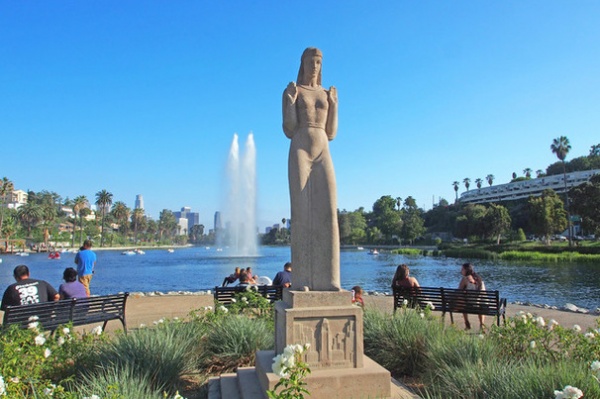
The high-rises of downtown L.A. are seen in the distance beyond Echo Park Lake and the art deco-style statue popularly known as the Lady of the Lake. The 1935 cast stone statue, officially called “Nuestra Reina de Los Angeles” (“Queen of the Angels”) is by artist Ada Mae Sharpless.
More: Superb Family Homes Pop Up in Forgotten Urban Spaces
Related Articles Recommended












